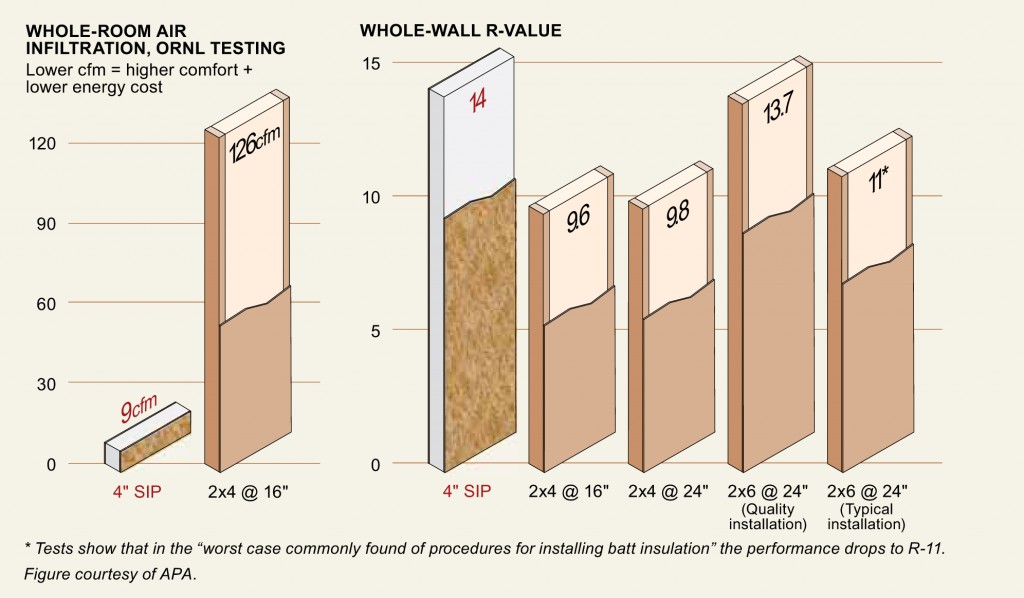Plasti-Fab
EPS Product Solutions
R-value – EPS core SIPs vs. Others
Posted on July 3, 2012 by Plasti-Fab
 Written by Dave Stevenson
Written by Dave Stevenson
Follow Dave on twitter @DStevensonSIP
One of the criteria that most energy rating programs have in common is an emphasis on R-value. In fact the NetZero Energy Home Coalition, the Passive Haus Standard, Canada’s EnerGuide Rating System and the USGBC’s LEED Rating System (just to name a few), all consider R-value to be a primary indicator of a building’s energy efficiency. For those who don’t know, R-value is the unit of measure for resistance to heat loss through a particular material; so simply stated, the higher the R-value the better thermal resistance, and hence, the lower the heat loss over time through the material.
Although R-value should be considered a serious factor when determining what materials will make up the building envelope, it’s important to understand that R-value only deals with heat loss by the 3 modes of heat flow through a material – conduction, convection and radiation. To put things into perspective, up to 60% of a building’s heat loss and energy use can be the result of air leakage, but I digress…
We’re here to discuss R-value; and in particular, Insulspan’s Expanded Polystyrene (EPS) core Structural Insulated Panel.
Here are some compelling reasons for choosing Insulspan’s EPS SIPs over any other type of SIP or insulated wall assembly.
- Bang for the buck EPS insulation has the highest R-value per cost ratio vs. any other insulation.
For example; fiberglass insulation is cheap, but as an insulator it is more subject to convection heat loss around it due to installation issues between framing members. When real world factors such as air infiltration, extreme temperatures and thermal bridging are present, field-installed fiberglass insulation can lose more than half its R-value. Blown in insulation such as urethane, or polyisocyanurate board insulation, may have slightly higher initial R-values, but are much more expensive, and come along with a whole host of other issues and limitations.
- EPS insulation is an air filled plastic insulation. This means it doesn’t off-gas or loose R-value over time.
Insulspan’s EPS core SIPs have an R-value of roughly R-4 per inch of thickness and the EPS core does not loose R-value over time. The same can’t be said for urethane or polyisocyanurate core panels that start out at an impressive R-7 per inch of thickness, but off-gas their blowing agent which provides the higher initial R-value, and settle over time at closer to R-5.
So in a nutshell –
R-value is important (maybe not as important as air-tightness), and Insulspan’s EPS core SIPs have the highest R-value to cost ratio compared to other insulated wall assemblies – they don’t off-gas, and they maintain their R-value over time.
Thermal Performance of the Insulspan SIP System
The Insulspan® SIP System provides wall and roof assemblies with higher overall (effective) thermal resistance (R-value) than other construction methods. The overall R-value of a building assembly includes the effect of thermal bridges as a result of framing members and is a measure of its ability to resist heat flow through it. The higher the overall R-value of a building assembly, the lower the long-term energy costs will be for heating and cooling.
The table below provides typical overall R-values calculated for wall and roof assemblies built with the Insulspan SIP System based upon:
- Wall and roof assemblies with gypsum board applied on the interior face.
- Wall assemblies with vinyl siding on the exterior face.
- Roof assemblies with sheathing paper with asphalt shingles on the exterior face.
- Insulspan SIP with expanded polystyrene (EPS) insulation core and exterior skins: of engineered oriented strand board (OSB) exterior rated sheathing.
- Panel to panel joint design options include OSB surface spline or 2x dimensional lumber.
R values in the Real World
For more information on R-values check out http://www.insulspan.com
Category: Structural Insulated PanelTags: building envelope, energy savings, EPS, expanded polystyrene, leed, lumber, net zero, panels, R-value, SIPS, thermal performance


The figure with air infiltration is not at all clear to me.The wall constructions are not clear, I think some are meant to show fiberglass batt insulation but not sure which ones are which. The SIP walls are identified, what are ther rest?
The numbers representing cfm are not readable. Is that on the left 126 or 12.6?
What are the units really? cfm per 100 square feet or cfm per one panel or what?
Al Hoar – Plasti-Fab Tech Centre.
What’s up colleagues, its enormous piece of writing regarding cultureand completely explained, keep it up all the time.
This design is spectacular! You definitely know how to keep a reader
amused. Between your wit and your videos, I was
almost moved to start my own blog (well, almost…HaHa!) Fantastic job.
I really loved what you had to say, and more than that, how you
presented it. Too cool!
Wonderful blog! Do you have any helpful hints for aspiring writers?
I’m hoping to start my own website soon but I’m a little lost on everything.
Would you propose starting with a free platform like WordPress or go
for a paid option? There are so many choices out there that I’m completely overwhelmed .. Any tips? Thanks!